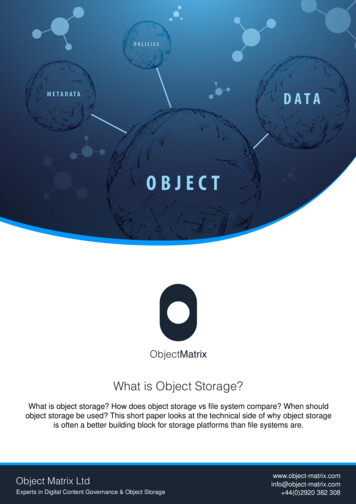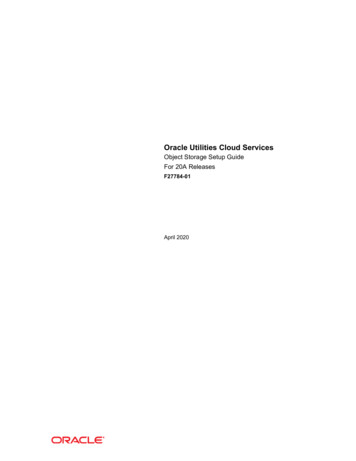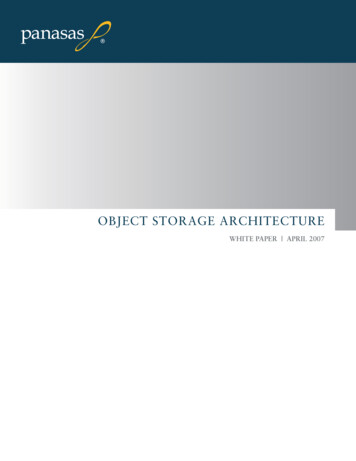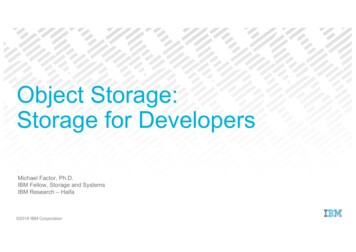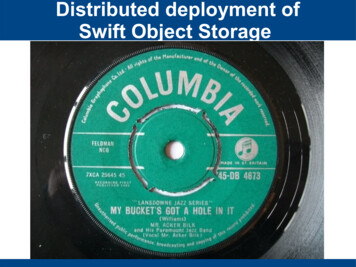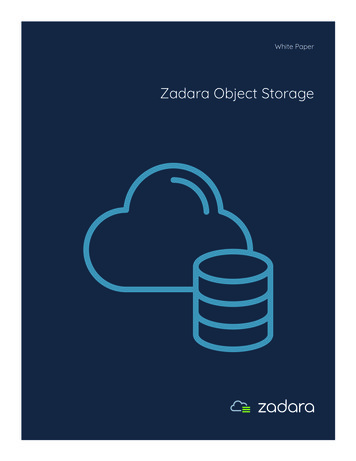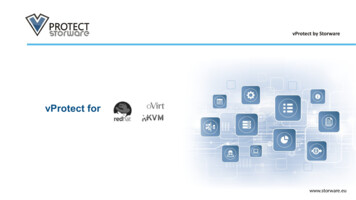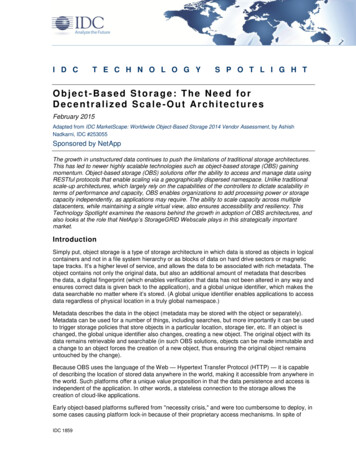
Transcription
I D CT E C H N O L O G YS P O T L I G H TObject-Based Storage: The Need forDecentralized Scale -Out ArchitecturesFebruary 2015Adapted from IDC MarketScape: Worldwide Object-Based Storage 2014 Vendor Assessment, by AshishNadkarni, IDC #253055Sponsored by NetAppThe growth in unstructured data continues to push the limitations of traditional storage architectures.This has led to newer highly scalable technologies such as object-based storage (OBS) gainingmomentum. Object-based storage (OBS) solutions offer the ability to access and manage data usingRESTful protocols that enable scaling via a geographically dispersed namespace. Unlike traditionalscale-up architectures, which largely rely on the capabilities of the controllers to dictate scalability interms of performance and capacity, OBS enables organizations to add processing power or storagecapacity independently, as applications may require. The ability to scale capacity across multipledatacenters, while maintaining a single virtual view, also ensures accessibility and resiliency. ThisTechnology Spotlight examines the reasons behind the growth in adoption of OBS architectures, andalso looks at the role that NetApp’s StorageGRID Webscale plays in this strategically importantmarket.IntroductionSimply put, object storage is a type of storage architecture in which data is stored as objects in logicalcontainers and not in a file system hierarchy or as blocks of data on hard drive sectors or magnetictape tracks. It’s a higher level of service, and allows the data to be associated with rich metadata. Theobject contains not only the original data, but also an additional amount of metadata that describesthe data, a digital fingerprint (which enables verification that data has not been altered in any way andensures correct data is given back to the application), and a global unique identifier, which makes thedata searchable no matter where it’s stored. (A global unique identifier enables applications to accessdata regardless of physical location in a truly global namespace.)Metadata describes the data in the object (metadata may be stored with the object or separately).Metadata can be used for a number of things, including searches, but more importantly it can be usedto trigger storage policies that store objects in a particular location, storage tier, etc. If an object ischanged, the global unique identifier also changes, creating a new object. The original object with itsdata remains retrievable and searchable (in such OBS solutions, objects can be made immutable anda change to an object forces the creation of a new object, thus ensuring the original object remainsuntouched by the change).Because OBS uses the language of the Web — Hypertext Transfer Protocol (HTTP) — it is capableof describing the location of stored data anywhere in the world, making it accessible from anywhere inthe world. Such platforms offer a unique value proposition in that the data persistence and access isindependent of the application. In other words, a stateless connection to the storage allows thecreation of cloud-like applications.Early object-based platforms suffered from "necessity crisis," and were too cumbersome to deploy, insome cases causing platform lock-in because of their proprietary access mechanisms. In spite ofIDC 1859
their from-the-ground-up design, and their departure from how traditional SAN and NAS arrays aredeployed and a lack of standard interfaces, object-based storage had been difficult to deploy. Thanksto the growing popularity of protocols such as Amazon’s S3, OpenStack SWIFT, and SNIA CDMIbecoming de facto RESTful access interfaces, this situation has changed. This has, in turn, spurredfurther investments in making OBS solutions simpler to deploy and ubiquitous.By comparison, increasing capacity in traditional storage infrastructures means setting up additionalservers, hard drives, and tape backups, along with increasing personnel to manage it all. Storageadministrators have also been burdened by estimating how much storage to provision. Getting thatcapacity amount wrong has meant not having the needed storage or overspending on unnecessarycapacity that then sits idle.With OBS, resiliency can be built-in, as one object can be automatically replicated and stored onmultiple devices across datacenters. For data that is accessed infrequently, life-cycle policies can beconfigured to active and archived objects.Object access control is also dictated by identity and access control lists. Uploads and downloads aresafeguarded with secure-socket layer (SSL) endpoints, as well as encryption for data at rest.The Need for Object-Based StorageNew deployment and delivery models such as online or cloud-based content delivery, mobileworkloads, digital archiving, and Big Data and business analytics are driving a need for scale-outarchitectures.The sheer amount of data being created by digital systems is growing in almost incomprehensibleproportions. In the past two years, more data has been created than in all previous history. Today,more than 4.4 zettabytes of data exist, but by 2020, that will grow tenfold to 44 zettabytes, accordingto the IDC Digital Universe Study.Over the next five years, businesses will more often be moving toward petabyte-scale data storage,and by way of their design, OBS solutions are turning out to be the right choice for balancing scale,complexity, durability, and costs for enormous data sets.The continued expansion of business-critical information, diverse data sets, new mobile and cloudservice platforms, and rich content within extended enterprises continues to change the storagedynamic in a wide range of industries and organizations. Regulated industries, such as healthcareand financial services, are often challenged to store data sets for extended periods while still beingable to quickly retrieve them.For example, in financial services and healthcare, documents and images are required to be kept foryears — even decades. A mammogram must be kept a minimum of five years, but, depending on thestate, may be required to be stored for the life of the patient. Under the Securities Exchange Act, Rule17a-4, broker-dealers must keep securities transaction records accessible at least six years. When aregulatory/legal challenge arises for a bank or brokerage, or a patient’s medical history is required,the data must be retrievable with little notice. This is especially the case for older data sets — i.e., thedurability and integrity of the objects are critical. Offline mechanisms like tape cannot offer this levelof integrity assurance.In the retail space, organizations collect data on customers, which can be used to analyze generalpopulace trends or individual habits. As the amount of data accumulates, it's often lost in time inirretrievable archives. Even data that retailers are unsure of how to use today may be useful as newanalytics platforms arise in the future, giving enterprises good reason to store too much data insteadof losing what could someday prove a goldmine of information.2 2015 IDC
Benefits Unique to Object-Based StorageBecause OBS uses a single, flat namespace for an object, replacing both path and filenames withobject identifiers, object addresses are nearly infinitely expandable. The object global namespacetransparency also makes it quick and easy to locate for users and distributed applications. Becauseapplications can be programmed to associate metadata with the stored objects, there is no need for adatabase on the application side.With OBS, files become immutable objects that cannot be manipulated because each is created withits own unique digital fingerprint, ensuring its integrity. If someone attempts to overwrite it, an OBSsystem will create a new object with its own unique identifier, keeping the original file intact.With good OBS systems, an object’s digital fingerprint of data is checked every time it's retrieved.OBS solutions like these are also beginning to offer an additional level of protection: If a user tries toretrieve a file that has become corrupted, the system doesn’t just offer an error message, but it alsorecovers an accurate object from backup while also repairing the bad one.Additionally, OBS systems can be set up to perform data health checks periodically to determine ifany files have become corrupted, while at the same time repairing them through error-correctioncoding.As data storage paradigms shift toward private, public, and hybrid clouds, OBS enables ITorganizations to shift IT resources from maintenance to new initiatives. Simply put, OBS deploymentsoffer flexibility to both grow and maintain storage, while also offering 24/7 access to data from anylocation and to any computer platform, whether it’s a traditional workstation or a mobile device.Objects are simple, easily distributed and replicated, and can be quickly and globally accessible inthe cloud. That makes objects perfect for active global archives and accessible through mobileapplications.Most enterprise hardware being shipped by vendors today is in support of unstructured data. Unitaryfile servers and scale-up appliances and gateways continue to decline due to capacity limits, whilescale-out or clustered file solutions continue to grow.At the same time, a generation of Web 2.0 vendors is creating new applications designed for use withobject-storage's RESTful interfaces, mainly Amazon’s S3 and OpenStack SWIFT.Additionally, industry support from the Object Storage Alliance and SNIA, with nearly two-dozenstorage vendor members, is helping educate enterprises on the use cases and the problems solvedby OBS.Key Characteristics of OBS PlatformsAn object platform is no good if it does not have adequate intelligence to handle "objects" of differenttypes. In other words, it needs to have extensive capabilities to extract the "DNA" from the object,which allows it to understand what this object is, place it on the appropriate storage tier, and maintainthe proper level of metadata detail.One of the key differentiators between true OBS platforms and scale-out file-based solutions withobject interfaces is how they manage data resiliency and dispersal. The more robust the objectplatform in terms of its dispersal capabilities, the better it is suited for cloud and cloud-likedeployments in which data may be ingested and/or analyzed concurrently across multiple locationsglobally and dispersed via replication and/or erasure coding on a granular basis (per object orcontainer). In addition, the platform needs to have robust clustering, data persistence, replication, and 2015 IDC3
conflict resolution capabilities. Earlier variants of OBS lacked this capability and therefore could notfunction in a multisite configuration.Look for platform scalability — not just hardware, but throughput, file size, and from file volumeperspectives. An OBS system that’s appropriate for a given environment will allow each dimension toscale independently.As with any storage system, data layout and organization is crucial for mining existing data forpatterns that may build new business cases. Users should consider a solution that supportsadvanced metadata, indexing, and analytics.As storage architectures continue to grow exponentially in size, there is a greater need for efficientdata management and reduction techniques. Because object storage uses metadata to describe afile, that information can be used to create automated data management policies. Key policies aplatform should offer include data protection through striping, compression, deduplication, andscheduled deletion.Data optimization technologies that include automated data tiering will also be key. An OBS solutionappropriate for a given environment will allow many, if not all, of the previously mentioned features.It’s also important to determine a vendor’s commitment to the platform now and for the future, and toconsider the vendor's past track record for incorporating new features over time. Established vendorshave greater R&D resources to develop new feature sets as a platform matures.Look for a vendor partner ecosystem, too, for applications and on-ramping. Unlike SAN and NAS,OBS has a less-established set of interfaces for existing enterprise applications. Therefore, the morecomprehensive the ecosystem, the better placed the supplier is to offer an end-to-end workloadoptimized or use-case-focused solution.Considering NetApp StorageGRID WebscaleNetApp has been selling StorageGRID Webscale as a software-defined OBS platform targeted atlarge-scale distributed content repository deployments. While StorageGRID is available as asoftware-only solution, the most common deployments are with NetApp E-Series storage, whereStorageGRID effectively utilizes E-Series DDP (dynamic disk pools) for node-level erasure coding,performance, and density. NetApp added the StorageGRID Webscale appliance for easier, moredense deployments. The appliance and software-only version can be mixed as needed in a singledeployment. The appliance comes in a 4U/60 drive form factor.NetApp StorageGRID Webscale is designed to eliminate the constraints of mapping data intopredefined containers as blocks or volumes, allowing repositories to accommodate billions of files orobjects and many petabytes of capacity in a single, unbounded repository that can span platforms,technologies, and sites. Webscale offers geo-distributed Erasure Coding controlled by a dynamicpolicy engine, enabling objects to move between storage tiers, locations and to be replicated.StorageGRID Webscale 10.1 has added several new features, including support for Amazon S3 as adata placement storage tier. It also supports a single policy engine that controls data placementacross private and public clouds.By providing a metadata-based policy management approach, StorageGRID Webscale transcendsthe limitations of traditional storage containers and hierarchical organization structures, allowing datato be organized, accessed, replicated, and managed using multiple user-defined and metadata-drivencriteria.4 2015 IDC
Data placement policies can be applied years after ingest, allowing business owners to adapt theirprotection strategies over time as business needs/rules change.NetApp StorageGRID Webscale is suitable for single-datacenter or multi-datacenter deploymentswith many sites across the globe. Key differentiators of the StorageGRID Webscale platform arenative support for S3, CDMI, and tape as well as the ability to continuously evaluate policies for anobject at rest. The StorageGRID Webscale platform is strong in its approach to multisiteconfigurations, a powerful policy-based management framework; security features such as tamperdetection, robust auditing, and its streaming architecture (versus a store and forward architecture)that enables reduced time to first byte; and efficient reads even when data is compressed orencrypted.The StorageGRID Webscale policy engine can drive a lower total cost of ownership. Unlike otherpolicy engines in the market, all application metadata (including S3 metadata) is available to theNetApp policy engine. Policies can be applied not only at ingest time, but at any other time, and newpolicies can be defined for objects at rest. This provides the flexibility to monitor and meet cost andperformance SLAs dynamically, instead of being locked into a particular policy. It allows enterprisesto meet and adapt to continuous changes in their business environments.IDC placed NetApp in the Major Players category in its IDC MarketScape: Worldwide Object-BasedStorage 2014 Vendor Assessment report. This position reflects NetApp's significant investment andproduct deliveries over the past year, as well as its quest to further penetrate this market and gaintraction among both its existing customer base and its newer customers by leveraging its existingposition in the storage industry.ChallengesHistorically NetApp’s StorageGRID hasn't had the same level of visibility inside of NetApp comparedwith its other storage platforms and solutions. This changed dramatically last year with the increasedinvestment in object storage and the subsequent release of StorageGRID Webscale, as well as theaddition of a field-facing organization focused on delivering NetApp's newest solutions (EmergingProducts Group).To take advantage of the opportunity provided by the launch of its newest OBS, NetApp needs to findspecific use cases for StorageGRID Webscale that cannot be satisfied just by deploying its FabricAttached Storage (FAS) or E-Series arrays.The company needs to continue to convince the market that its OBS platform is not a fulfilmentmechanism for its other storage offerings, and that it's indeed serious about this emerging softwarebased storage market segment. NetApp also has to go above and beyond to convince the marketthat it offers the same level of support that its customers enjoy for its principal platforms. The fact thatNetApp has added AutoSupport to its OBS is a step in the right direction — to bring many of theenterprise-grade features to OBS solutions.The value of the object platform lies in the number and diversity of solutions it enables. It can besolutions for unstructured data, geographically dispersed data and computing, and semistructureddata, as well as across industries like healthcare, energy, manufacturing, and research to name afew.Given NetApp's success in the storage market, it is well-positioned to continue to further improve itsreputation in the OBS market in the near future. 2015 IDC5
ConclusionOutside the datacenter, storage traffic is undergoing a dramatic shift as the growth of mobile, social,and cloud is heavily tilted toward the use of IP-based connectivity mechanisms for consuming storageresources. As businesses move toward petabyte-scale data storage, object-based storagearchitectures are turning out to be the right choice for balancing scale, complexity, and costs.A B O U TT H I SP U B L I C A T I O NThis publication was produced by IDC Custom Solutions. The opinion, analysis, and research results presented hereinare drawn from more detailed research and analysis independently conducted and published by IDC, unless specific vendorsponsorship is noted. IDC Custom Solutions makes IDC content available in a wide range of formats for distribution byvarious companies. A license to distribute IDC content does not imply endorsement of or opinion about the licensee.C O P Y R I G H TA N DR E S T R I C T I O N SAny IDC information or reference to IDC that is to be used in advertising, press releases, or promotional materials requiresprior written approval from IDC. For permission requests contact the Custom Solutions information line at 508-988-7610 orgms@idc.com. Translation and/or localization of this document require an additional license from IDC.For more information on IDC visit www.idc.com. For more information on IDC Custom Solutions visithttp://www.idc.com/prodserv/custom solutions/index.jsp.Global Headquarters: 5 Speen Street Framingham, MA 01701 USA P.508.872.8200 F.508.935.4015 www.idc.com6 2015 IDC
Adapted from IDC MarketScape: Worldwide Object-Based Storage 2014 Vendor Assessment, by Ashish Nadkarni, IDC #253055 Sponsored by NetApp The growth in unstructured data continues to push the limitations of traditional storage architectures. This has led to newer highly scalable technologies such as object-based storage (OBS) gaining momentum.


